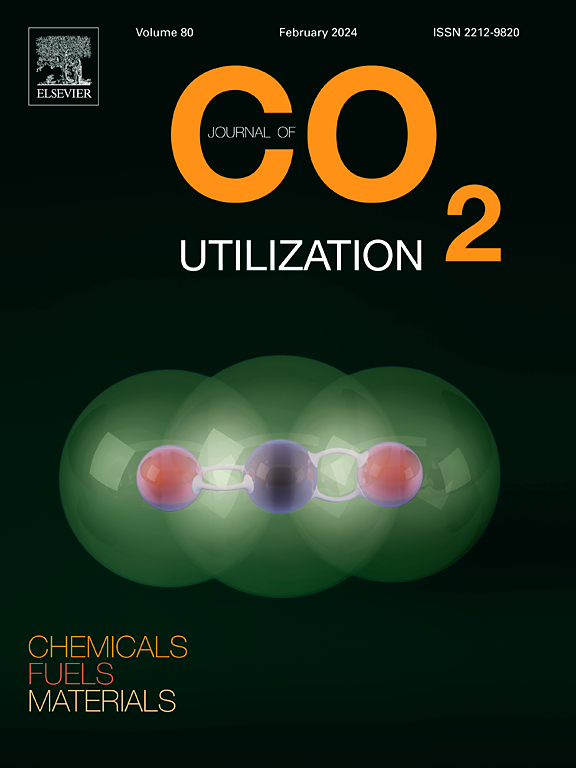在羟基磷灰石负载的Ni催化剂上非热等离子体增强逆水气转换反应:苛刻工艺条件的影响
IF 8.4
2区 工程技术
Q1 CHEMISTRY, MULTIDISCIPLINARY
引用次数: 0
摘要
二氧化碳加氢生成一氧化碳和水(逆水气变换反应)是一种很有前途的二氧化碳气化方法。这是甲醇合成和费托合成的第一步。然而,热力学障碍限制了该工艺的工业规模,因此,对合适的催化剂配方和反应器配置的需求仍在继续。在微波等离子体反应器中,研究了羟基磷灰石负载镍氧化锆催化剂对CO2加氢制一氧化碳的催化性能。采用湿浸渍法制备10 wt% Ni- ZrO2/HAp催化剂,180℃干燥18 h, 500℃煅烧3 h。研究了H2/CO2摩尔比、功率和GHSV对CO2转化率和CO选择性的影响。在选择的GHSV范围内,不影响输出参数。在所有实验中,CO的选择性都保持在98 ~ 100 %之间。在H2/CO2∶2:1、功率= 2.25 kW、GHSV= 80000 mL.gr−1条件下,产碳率最高为83 %。Hr−1,同时保持9 %能源效率。由于碱性催化剂与CO2(弱酸)的相互作用促进了CO2还原为CO,同时微波放电反应器的温度特性满足了RWGS反应的要求,证明了CO2的高转化率是合理的。此外,在H2/CO2比为1:1,功率= 0.8 kW, GHSV= 120,000 mL.gr−1.hr−1的情况下,能源效率为28 %。据我们所知,这些价值以前从未达到过。在本研究中,我们提出了一种新的CO2加氢反应催化剂配方,对反应进行了微波放电测试,并在非常高的GHSV水平下进行了操作,适合于工业生产。本文章由计算机程序翻译,如有差异,请以英文原文为准。
Non-thermal plasma-enhanced reverse water-gas shift reaction over hydroxyapatite-supported Ni catalyst: Effect of severe process conditions
CO2 hydrogenation to carbon monoxide and water (Reverse Water Gas Shift reaction) is a promising way to valorize CO2. It is the preliminary step in the methanol and Fischer-Tropsch synthesis processes. However, the thermodynamic barrier has limited the industrial scale-up of this process, and thus, the need for a proper catalyst formulation and reactor configuration is still ongoing. In this paper, we studied the catalytic performance of a hydroxyapatite-supported nickel-zirconia catalyst in a microwave plasma reactor for the CO2 hydrogenation to carbon monoxide. A 10 wt% Ni- ZrO2/HAp catalyst was prepared by the wetness impregnation method, dried at 180 °C for 18 h and calcined at 500°C for 3 h. The influence of the H2/CO2 molar ratio, power, and GHSV on CO2 conversion and CO selectivity was studied. In the selected range of GHSV, it did not influence the output parameters. Moreover, CO selectivity remained in the range of 98–100 % in all experiments. The highest carbon yield was 83 % under H2/CO2 to 2:1, Power= 2.25 kW, and GHSV= 80,000 mL.gr−1.hr−1 while maintaining 9 % energy efficiency. The high CO2 conversion is justified due to the interaction of a basic catalyst with the CO2 (weak acid) which facilitated the CO2 reduction to CO as well as the microwave discharge reactor, whose temperature characteristics meet the requirement of the RWGS reaction. In addition, an energy efficiency equal to 28 % was observed under H2/CO2 to 1:1, Power= 0.8 kW, and GHSV= 120,000 mL.gr−1.hr−1. To the best of our knowledge, these values have never been attained before. In this study, we proposed a novel catalyst formulation for the CO2 hydrogenation reaction, tested a microwave discharge for the reaction, and operated at very high GHSV levels, which are suitable for industrial production.
求助全文
通过发布文献求助,成功后即可免费获取论文全文。
去求助
来源期刊

Journal of CO2 Utilization
CHEMISTRY, MULTIDISCIPLINARY-ENGINEERING, CHEMICAL
CiteScore
13.90
自引率
10.40%
发文量
406
审稿时长
2.8 months
期刊介绍:
The Journal of CO2 Utilization offers a single, multi-disciplinary, scholarly platform for the exchange of novel research in the field of CO2 re-use for scientists and engineers in chemicals, fuels and materials.
The emphasis is on the dissemination of leading-edge research from basic science to the development of new processes, technologies and applications.
The Journal of CO2 Utilization publishes original peer-reviewed research papers, reviews, and short communications, including experimental and theoretical work, and analytical models and simulations.
 求助内容:
求助内容: 应助结果提醒方式:
应助结果提醒方式:


